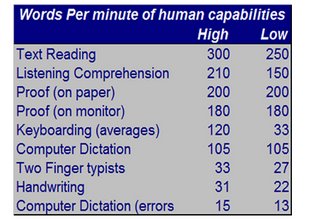Keyboarding: The Hidden Giant of Web 2.0

We had a great discussion this past week on the WOW2 edtechtalk (Listen to the podcast.) as we discussed the importance of teaching keyboarding and the impact of ignoring this issue on efforts to move towards on Web 2.0.
As we researched this topic, I came across some amazing statistics in an article on Human Interaction Speeds. I've shown them in a table to the left. (Human Interaction Speeds by Bob Bailey)
I believe that many schools just think kids should "know" how to type. It is a skill with a lifelong impact. We are currently in an information society and it is vital that students produce it efficiently.
I hear a lot of talk about the efficiency that comes with typing and using the computer, however if you look at the research - two finger typing at its best gives a student 2 extra words per minute than handwriting! There is no measurable productivity gain by moving to the computer if students aren't given keyboarding instruction.
Educators are trying to put more into the day. Reviewing this article, I see two great ways to improve student performance:
1) Teach effective keyboarding skills
This is my second semester with over 70 words per minute. (I had a year before with over 60 words per minute.) Every student has broken 30 words per minute for the last two years. We keyboard daily for a semester. I have other curricular objectives, but the focus is keyboarding.
I was a failure my first year. I had to teach students every other day either two or three times a week. My class average was in the high 20's. I felt like a failure!
There is a right and a wrong way to teach keyboarding. I use the methodologies (and textbook) used by my mother, an expert business education teacher. I use a book supplemented by Mavis Beacon, however 90% of the work is supervised by me and uses the book. I focus on technique.
Look at the lifetime difference of my students versus a student not taught. At 70 words per minute, my students will be able to get work done almost three times as fast as another person. They will e-mail faster. They will IM faster. They will be able to focus on thinking and not on getting a product on paper!
2) Teach Speed Reading
When I look back at the article, they mention the effect of speed reading. The article says that using Rapid Serial Visualization Representation (RSVP) speed reading, a person can read at speeds of 600 to 800 words per minute. I actually did a speed reading book last summer and have seen a significant increase in my reading speeds. What would this do in schools?
How can schools afford to NOT teach keyboarding?
As we discussed this issue via skypecast this week, the overriding comment is that schools do not seem to have the time to teach keyboarding.
Faster typists can cover more material
I look at it from a production standpoint. When a student can type faster they can take notes faster, wiki faster, type papers faster, and have more time to study, so in effect they will become a better student!
We teach keyboarding for 6 weeks in 5th grade and a semester in eighth. Yes, it is tough to fit in, but good education is never easy. There is great research on this topic.
Keyboarding is not a vocational subject
I also take issue with the fact that keyboarding is considered a vocational subject. It is the most college prep subject that I know of!
Look at the world! We are producing INFORMATION! Widgets are going overseas. And now, information is beginning to go overseas because they can produce it faster. We're still training vocational students to be secretaries when I know CEO's who type their own letters!
Take a listen to the podcast and let me know what you think. What is your school doing? Do all students take it? What ages do you teach it?
Tags: